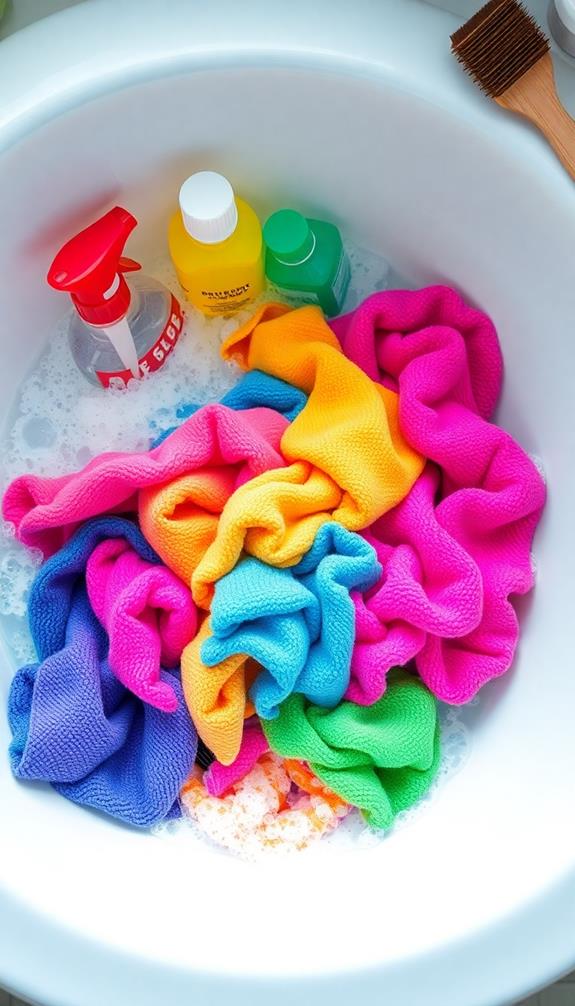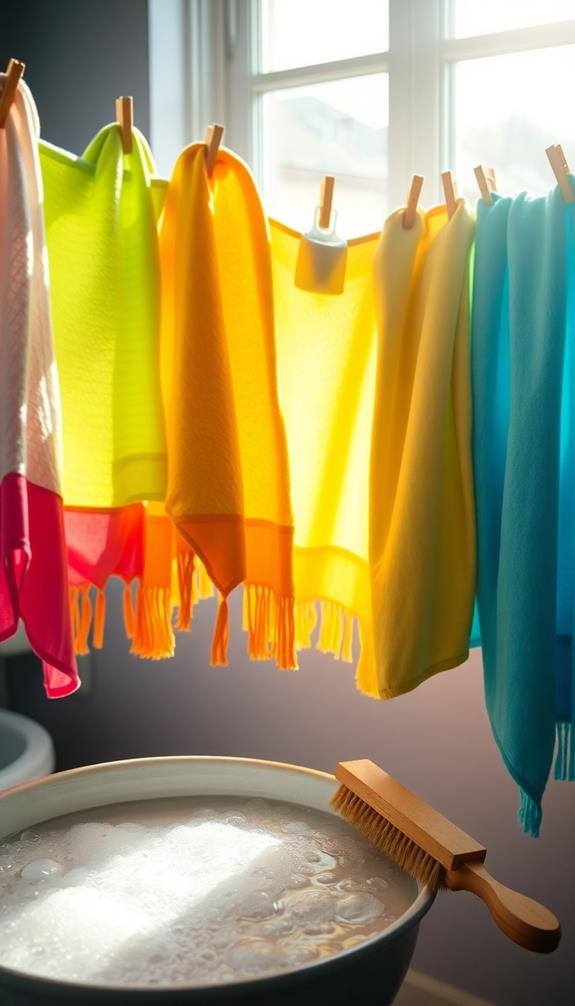To wash your rags properly for lasting freshness, start by sorting them by color and fabric type. Pre-treat any stains with a suitable stain remover, then soak them in warm, soapy water for 30 minutes. Use hot water and a heavy-duty detergent when you wash them. After washing, air-dry the rags in a well-ventilated space to maintain their absorbency and prevent damage. Verify they're completely dry before storing them in a cool, dry area. If you want to extend their life even further, keep exploring additional tips and tricks.
Importance of Clean Rags
When you think about running a mechanic shop or car wash, clean rags are more than just a necessity—they're essential for keeping everything running smoothly. Having a steady supply of cleaning rags helps you swiftly tackle spills and contaminants, ensuring your workspace remains hygienic and efficient.
Regularly using non-toxic cleaning solutions like vinegar and baking soda not only enhances your cleaning routine but also contributes to a healthier environment for both employees and customers, promoting safe sanitization practices. Dirty rags can lead to cross-contamination and a messy environment, which could ultimately affect customer satisfaction.
Regularly laundering your rags prevents stains and extends their lifespan, saving you money on replacements. It's crucial to separate oil-stained rags from others to avoid grease transfer. If you wash dirty rags promptly, you'll minimize the risk of permanent stains, allowing you to keep your rags clean and fresh for future use.
Air-drying your rags after washing is another key step; it helps maintain their absorbency and prevents damage, ensuring they stay effective.
Supplies Needed for Washing
To effectively wash rags, you'll need a few essential supplies that streamline the process. Start with a bucket or basin to soak your rags before washing. Gather laundry detergent, as it's key to breaking down dirt and grime. Hot water is also necessary, as it enhances the detergent's cleaning power. Utilizing natural cleaning solutions like vinegar can also help in maintaining the freshness of your rags.
Don't forget to wear sturdy rubber gloves to protect your hands from chemicals and bacteria while handling dirty rags. A scrub brush can be helpful for tackling particularly stubborn stains during the washing process.
Organize your workspace efficiently by sorting the rags by their level of soiling or intended use. This will help you manage the washing process better and guarantee your towels come out cleaner.
It's also smart to prepare a designated drying area, like a clothesline or drying rack, to allow for proper air circulation and drying once the rags are washed.
Stain Treatment Techniques

Inspect your rags for any tough stains before diving into the washing process. If you spot a stain, apply a store-bought stain remover or a homemade solution made of equal parts hydrogen peroxide and water directly onto the stained area. Let it sit for about 10 minutes, then scrub gently to lift the stain.
For greasy stains, pre-treat by sprinkling cornstarch or talcum powder to absorb the excess oil. This can greatly enhance your cleaning results, especially since effective cleaning techniques for grease removal can make a big difference in maintaining kitchen cleanliness.
Next, fill a basin with warm water, adding laundry detergent or stain remover. Submerge your rags fully and agitate gently, allowing them to soak for at least 30 minutes, especially if they're heavily stained. This soaking time is vital for loosening dirt and grime.
After soaking, rinse your rags under running water to remove all soap residue. This step guarantees they're clean before heading to the washing machine.
For particularly stubborn stains like paint or ink, make sure to spot treat with rubbing alcohol or hydrogen peroxide before you wash, boosting their removal effectiveness.
Effective Washing Methods
When you wash rags, start by pre-treating any stubborn stains to improve your results.
To enhance cleaning results, sort them by color and fabric type, which can also help sort clothes by fabric type or color to avoid color bleeding and damage.
Pre-Treatment Techniques
Properly pre-treating your rags can make all the difference in their cleanliness and longevity. Start by inspecting each rag for tough stains. Apply a stain remover or a homemade solution of equal parts hydrogen peroxide and water directly onto the stained areas. Let it sit for about 10 minutes to allow for effective penetration.
Gently rub the stained areas using your fingers or an old toothbrush to loosen the dirt.
Next, soak the rags in a warm water solution mixed with laundry detergent for at least 30 minutes. If you're dealing with grease-heavy rags, sprinkle cornstarch or talcum powder on them to absorb excess grease before washing. This step enhances the effectiveness of your cleaning process.
Always wear rubber gloves during the pre-treatment to protect your hands from chemicals and bacteria.
After soaking, rinse the rags under running water until all soap residue is removed. This thorough pre-treatment process is essential for maximizing the cleanliness and longevity of your rags, setting them up for an effective wash.
Washing and Drying
After pre-treating your rags, it's time to focus on washing and drying them effectively. First, sort your rags by color and fabric type to prevent color bleeding and guarantee that each material gets the proper care.
For greasy rags, use high heat and a heavy-duty detergent. Pre-treat any stubborn stains with commercial grease removers or a homemade mix of hydrogen peroxide and water.
When you're ready to wash, place your rags in a mesh laundry bag. This minimizes lint spread and keeps them separate from your regular laundry to avoid cross-contamination.
For machine washing, a warm or hot cycle works best, depending on the fabric type.
Once washed, consider air-drying your rags to maintain their absorbency and lifespan. If you prefer using a dryer, set it to medium heat and promptly remove the rags to prevent wrinkles.
After drying, regularly inspect your rags for wear and tear. If they feel stiff or aren't cleaning effectively anymore, it might be time to replace them.
Proper washing and drying will keep your rags fresh and ready for the next use.
Storing Clean Rags
To keep your clean rags in top shape, it's crucial to store them correctly. First, make sure your rags are completely dry before putting them away. Any dampness can lead to mildew and unpleasant odors, so take this step seriously.
Store clean rags in a cool, dry, and well-ventilated area. This helps maintain their freshness and absorbency over time.
Consider using labeled containers or bins to organize your rags by type or intended use. This way, you can easily find what you need while keeping everything neat and clean.
Folding your rags neatly not only saves space but also prevents them from getting wrinkled or tangled during storage.
Don't forget to rotate your towel stock regularly. This guarantees even usage and prolongs the overall lifespan of your cleaning rags.
Drying Options for Rags

When it comes to drying rags, you've got a couple of options that can help maintain their quality. One effective method is to air-dry your rags. This process guarantees that they retain their absorbency and prevents any damage that high heat can cause over time.
For example, using eco-friendly methods, such as air-drying, aligns with green cleaning practices to keep your cleaning tools in top shape. Simply hang the rags in a well-ventilated area until they're completely dry. Before you hang them, be sure to shake out any remaining lint and debris for a cleaner finish.
If you prefer using a dryer, set it to a medium heat setting for about 30 minutes. Make sure to remove the rags promptly once the drying cycle ends to avoid wrinkles, confirming they're fully dried. You might consider adding a fabric softener sheet to enhance the scent; however, skip this for microfiber rags, as it can reduce their absorbency.
Regardless of the method you choose, proper drying is vital to maintain your rags' effectiveness and freshness. By following these drying options for rags, you'll keep them in great shape for future use.
Proper Storage Practices
Proper storage practices are essential for keeping your rags in top condition, as storing them incorrectly can lead to mildew, odors, and diminished effectiveness. To guarantee your rags remain fresh and ready for use, follow these key steps:
1. Store in a Cool, Dry Place: Keep your clean rags in a cool, dry, and well-ventilated area. This helps prevent mildew and unpleasant odors, maintaining their freshness.
Additionally, using well-organized storage methods, such as drawer organizers, can enhance accessibility and keep your rags in prime condition.
2. Use Labeled Containers: Organize rags by type and intended use using labeled bins. This not only makes it easier to find what you need but also reduces the risk of cross-contamination.
3. Fold Neatly: Fold your rags neatly to save space and allow for easy access. This also helps prevent dust and dirt from accumulating before their next use.
4. Keep Away from Stains: Store your rags away from chemicals and potential stain sources to maintain their cleanliness and effectiveness for future cleaning tasks.
Maintenance Tips for Longevity

Maintaining your rags is key to guaranteeing they last longer and perform well. One of the best maintenance tips for longevity is to regularly launder your shop rags. This prevents stains from setting in, allowing them to stay effective for several months to a year depending on how often you use them.
Always separate oil-stained rags from other laundry to minimize cross-contamination and keep your clean rags in top shape. Incorporating eco-friendly cleaning methods can further enhance the longevity of your rags, as natural cleaners like vinegar and baking soda are less likely to degrade fabric fibers compared to harsh chemicals. For a more sustainable approach, consider using natural cleaning methods that are safe for your rags.
Before you start your wash cycle, consider soaking heavily soiled rags in warm, soapy water. This enhances cleanliness and reduces the risk of lingering odors.
After washing, air-dry your rags rather than tossing them in the dryer. High heat can damage the fibers, while air-drying maintains their absorbency, leading to better durability over time.
Regularly inspect your rags for any stiffness or reduced effectiveness. If you notice these signs, it's time to replace them to maintain your cleaning efficiency.
When to Dispose of Rags
Knowing when to dispose of rags is crucial for maintaining effective cleaning practices, especially in environments where grease accumulation can pose health risks and fire hazards.
Regularly checking your rags helps guarantee they remain useful and hygienic, as proper kitchen grease cleanup is essential for a safe cooking environment.
Here are key indicators that it's time to dispose of rags:
- Stiffness After Washing: If your rags feel stiff and rough even after washing, their effectiveness is compromised.
- Reduced Absorbency: A noticeable decrease in absorbency means these soiled rags can no longer soak up spills efficiently.
- Persistent Stains: If stains won't budge despite your best cleaning efforts, it's time to replace them. Stains can harbor bacteria and diminish hygiene.
- Contamination with Hazardous Materials: Rags used with hazardous substances must be disposed of properly to prevent environmental hazards and health risks.
Conclusion
By keeping your rags clean and fresh, you're ensuring they last as long as a loyal friend. Proper washing, drying, and storage will not only maintain their effectiveness but also save you money in the long run. Remember, a little care goes a long way. So, treat your rags with the respect they deserve, and they'll be ready to tackle any mess, just like a trusty sidekick always at your side.